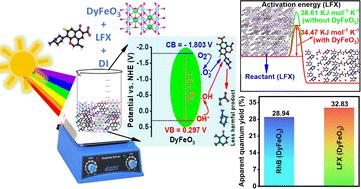当前位置:
X-MOL 学术
›
J. Mater. Chem. A
›
论文详情
Our official English website, www.x-mol.net, welcomes your feedback! (Note: you will need to create a separate account there.)
Nanostructured DyFeO3 photocatalyst: an authentic and effective approach for remediation of industrial and pharmaceutical wastewater
Journal of Materials Chemistry A ( IF 10.7 ) Pub Date : 2024-08-28 , DOI: 10.1039/d4ta04728a Mohasin Tarek 1 , Ferdous Yasmeen 1 , M. A. Basith 1
Journal of Materials Chemistry A ( IF 10.7 ) Pub Date : 2024-08-28 , DOI: 10.1039/d4ta04728a Mohasin Tarek 1 , Ferdous Yasmeen 1 , M. A. Basith 1
Affiliation

|
The persistent issue of water contamination by industrial dyes and pharmaceutical residues has created an urgent need for advanced photocatalytic materials to effectively address environmental remediation. Despite ongoing research, developing novel photocatalysts with ideal band structures, high quantum yields, and strong stability remains a considerable challenge. In this study, we report the synthesis and detailed characterization of nanostructured dysprosium orthoferrite (DyFeO3) nanoparticles, designed with a porous architecture featuring an average pore size of 3.41 nm and a surface area of 23.25 m2 g−1 to enhance photocatalytic efficiency under solar irradiation. Using Inverse Fast Fourier Transform (FFT) analysis on selected areas of TEM images, we gained deeper insights into the formation and internal structure of these nanoparticles. DyFeO3 nanoparticles exhibit a direct band gap of 2.1 eV, making them particularly effective for solar light absorption. Comprehensive spectroscopic analyses, including Mott–Schottky measurements and valence band XPS, confirmed their n-type semiconducting nature and revealed an electronic band structure that supports efficient oxygen reduction and oxidation reactions. Additionally, time-resolved photoluminescence spectroscopy demonstrated a charge carrier lifetime of 2.43 ns, indicating efficient separation and transport of photogenerated charge carriers. The photocatalytic performance of DyFeO3 was evaluated through degradation experiments using two model pollutants: Rhodamine B (RhB) and Levofloxacin (LFX). The nanoparticles successfully degraded both the colored RhB and the colorless LFX, eliminating concerns of dye sensitization. Furthermore, the presence of DyFeO3 significantly reduced the activation energy for RhB degradation from 55.87 kJ mol−1 K−1 to 34.58 kJ mol−1 K−1 and for LFX from 38.4 kJ mol−1 K−1 to 34.1 kJ mol−1 K−1, demonstrating its catalytic efficiency. With apparent quantum yield values of 28.94% for RhB and 32.83% for LFX, these nanoparticles demonstrate exceptional solar energy harvesting capabilities. The high degradation efficiency, quantum yield, and stability of the single-structured DyFeO3 nanoparticles highlight their potential for large-scale applications in photocatalytic and environmental remediation technologies.
中文翻译:

纳米结构 DyFeO3 光催化剂:一种真实有效的工业和制药废水修复方法
工业染料和药物残留物造成的水污染问题持续存在,迫切需要先进的光催化材料来有效解决环境修复问题。尽管研究正在进行,开发具有理想能带结构、高量子产率和强稳定性的新型光催化剂仍然是一个巨大的挑战。在这项研究中,我们报告了纳米结构镝正铁氧体(DyFeO 3 )纳米颗粒的合成和详细表征,该纳米颗粒采用多孔结构设计,平均孔径为3.41 nm,表面积为23.25 m 2 g -1 ,可提高光催化效率太阳辐射。通过对 TEM 图像的选定区域进行快速傅里叶逆变换 (FFT) 分析,我们对这些纳米粒子的形成和内部结构有了更深入的了解。 DyFeO 3纳米颗粒的直接带隙为 2.1 eV,这使得它们对于太阳光吸收特别有效。全面的光谱分析,包括莫特-肖特基测量和价带 XPS,证实了它们的 n 型半导体性质,并揭示了支持有效氧还原和氧化反应的电子能带结构。此外,时间分辨光致发光光谱显示载流子寿命为 2.43 ns,表明光生载流子的有效分离和传输。 DyFeO 3的光催化性能通过使用两种模型污染物:罗丹明B (RhB) 和左氧氟沙星(LFX) 的降解实验进行评估。 纳米颗粒成功降解了有色 RhB 和无色 LFX,消除了染料敏化的担忧。此外,DyFeO 3的存在显着降低了RhB降解的活化能从55.87 kJ mol -1 K -1至34.58 kJ mol -1 K -1以及LFX从38.4 kJ mol -1 K -1至34.1 kJ mol -的活化能。 1 K -1 ,证明其催化效率。 RhB 的表观量子产率为 28.94%,LFX 的表观量子产率为 32.83%,这些纳米粒子表现出卓越的太阳能收集能力。单结构DyFeO 3纳米颗粒的高降解效率、量子产率和稳定性凸显了其在光催化和环境修复技术中大规模应用的潜力。
更新日期:2024-08-28
中文翻译:

纳米结构 DyFeO3 光催化剂:一种真实有效的工业和制药废水修复方法
工业染料和药物残留物造成的水污染问题持续存在,迫切需要先进的光催化材料来有效解决环境修复问题。尽管研究正在进行,开发具有理想能带结构、高量子产率和强稳定性的新型光催化剂仍然是一个巨大的挑战。在这项研究中,我们报告了纳米结构镝正铁氧体(DyFeO 3 )纳米颗粒的合成和详细表征,该纳米颗粒采用多孔结构设计,平均孔径为3.41 nm,表面积为23.25 m 2 g -1 ,可提高光催化效率太阳辐射。通过对 TEM 图像的选定区域进行快速傅里叶逆变换 (FFT) 分析,我们对这些纳米粒子的形成和内部结构有了更深入的了解。 DyFeO 3纳米颗粒的直接带隙为 2.1 eV,这使得它们对于太阳光吸收特别有效。全面的光谱分析,包括莫特-肖特基测量和价带 XPS,证实了它们的 n 型半导体性质,并揭示了支持有效氧还原和氧化反应的电子能带结构。此外,时间分辨光致发光光谱显示载流子寿命为 2.43 ns,表明光生载流子的有效分离和传输。 DyFeO 3的光催化性能通过使用两种模型污染物:罗丹明B (RhB) 和左氧氟沙星(LFX) 的降解实验进行评估。 纳米颗粒成功降解了有色 RhB 和无色 LFX,消除了染料敏化的担忧。此外,DyFeO 3的存在显着降低了RhB降解的活化能从55.87 kJ mol -1 K -1至34.58 kJ mol -1 K -1以及LFX从38.4 kJ mol -1 K -1至34.1 kJ mol -的活化能。 1 K -1 ,证明其催化效率。 RhB 的表观量子产率为 28.94%,LFX 的表观量子产率为 32.83%,这些纳米粒子表现出卓越的太阳能收集能力。单结构DyFeO 3纳米颗粒的高降解效率、量子产率和稳定性凸显了其在光催化和环境修复技术中大规模应用的潜力。





































 京公网安备 11010802027423号
京公网安备 11010802027423号